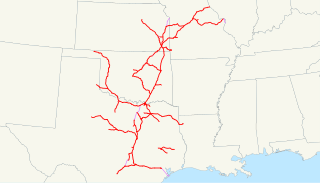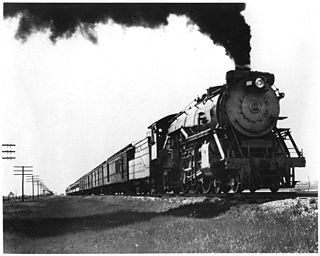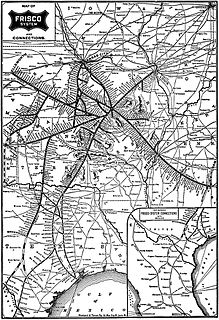Related Research Articles

Jefferson County is a county located in the U.S. state of Oklahoma. As of the 2010 census, the population was 6,472. Its county seat is Waurika. The county was created at statehood and named in honor of President Thomas Jefferson.

Waurika is the county seat of Jefferson County, Oklahoma, United States. The population was 2,064 at the 2010 census, a 4.36 percent decrease from 2,158 at the 2000 census.

The Missouri–Kansas–Texas Railway is a former Class I railroad company in the United States, with its last headquarters in Dallas, Texas. Established in 1865 under the name Union Pacific Railway, Southern Branch, it came to serve an extensive rail network in Texas, Oklahoma, Kansas, and Missouri. In 1988, it merged with the Missouri Pacific Railroad; today, it is part of Union Pacific Railroad.
The Midland Valley Railroad (MV) was incorporated on June 4, 1903 for the purpose of building a line from Hope, Arkansas, through Muskogee and Tulsa, Oklahoma to Wichita, Kansas. It was backed by C. Jared Ingersoll, a Philadelphia industrialist who owned coal mining properties in Indian Territory. The railroad took its name from Midland, Arkansas, a coal mining town in western Arkansas, which was served by the railroad. The Midland Valley gained access to Fort Smith, Arkansas via trackage rights over the Frisco from Rock Island, Oklahoma.

The Wichita, Tillman and Jackson Railway is a shortline railroad subsidiary of the Rio Grande Pacific Corporation that operates in Oklahoma and Texas. The line for which it is named extends from Wichita Falls, Texas to just north of Altus, Oklahoma, through Wichita County, Texas, Tillman County, Oklahoma, and Jackson County, Oklahoma. It interchanges with the Union Pacific (UP) and BNSF at Wichita Falls, with Farmrail (FMRC), Stillwater Central Railroad (SLWC), and the BNSF at Altus, and with Grainbelt (GNBC) at Frederick, Oklahoma. It carries predominately grain, chemicals and agricultural products.
The Oklahoma City – Ada – Atoka Railway (OCAA) was formed from trackage from Oklahoma City to Atoka via Shawnee, Ada, and Coalgate, Oklahoma. Atoka to Coalgate had been built between 1882 and 1886 as feeder to the old Missouri–Kansas–Texas Railroad (Katy) main line, and Coalgate-Shawnee-Oklahoma City had been constructed by Katy affiliates, and specifically the first 40 miles northwest out of Coalgate having been built by the Texas and Oklahoma Railroad in 1902, and the remaining 78 miles into Oklahoma City having been built in the 1903-1904 timeframe by that line’s successor, the Missouri, Kansas and Oklahoma Railroad Company. However, these properties were not included in the 1923 reorganization of the Katy, and were put in the OCAA instead. The OCAA ended up being sold to the Muskogee Company in 1929, becoming one of the Muskogee Roads.

The Fort Worth and Denver Railway, nicknamed "the Denver Road", was a class I American railroad company that operated in the northern part of Texas from 1881 to 1982, and had a profound influence on the early settlement and economic development of the region.
The Oklahoma, Kansas and Texas Railroad (OKT) was a railroad operating in its namesake states in the 1980s.

The Panhandle and Santa Fe Railway (P&SF) is a now-defunct railroad company that was a subsidiary of the Atchison, Topeka and Santa Fe Railway (AT&SF), operating primarily in the Texas Panhandle.

The Texas Zephyr was a named passenger train operated by the Colorado & Southern Railway and the Fort Worth & Denver Railway. The train was originally designated number 1 southbound, and number 2 northbound.
Article X of the Texas Constitution of 1876 covers railroad companies and the creation of the Railroad Commission of Texas. The federal government later created the Interstate Commerce Commission to regulate railroads, and eight of the nine sections of Article X were repealed in 1969 as "deadwood".
The following is a brief history of the North American rail system, mainly through major changes to Class I railroads, the largest class by operating revenue.

The Fort Worth and Rio Grande Railway, chartered under the laws of Texas on June 1, 1885, was part of a plan conceived by Buckley Burton Paddock and other Fort Worth civic leaders to create a transcontinental route linking New York, Fort Worth, and the Pacific port of Topolobampo, which they believed would stimulate the growth and development of southwest Texas in general, and the economy of Fort Worth in particular.

The Trinity and Brazos Valley Railway of Texas came into existence on October 7, 1902, originally chartered to build a railroad from Johnson County to the Beaumont area near the Gulf coast. It took its name from the Trinity and Brazos rivers. It was commonly known as the “Boll Weevil," though it referred to itself as the "Valley Road."
The Clinton and Oklahoma Western Railroad was a railway in southwestern Oklahoma and the Texas Panhandle, with a mainline eventually running from Clinton, Oklahoma to Pampa, Texas, about 139 miles. The predecessor company was incorporated in 1908, and the railroad was merged out of existence in 1948.
The Wichita Falls and Northwestern Railway, its affiliate the Northwestern Railway Company of Texas, and two subsidiaries collectively constructed a railway running from Wichita Falls, Texas through Altus, Oklahoma to Forgan, Oklahoma, with a branch running from Altus to Wellington, Texas. The network comprised 359.3 miles of track, and was collectively known as the Wichita Falls Route.
The Lawton, Wichita Falls and Northwestern Railway was an effort around the time of Oklahoma statehood to build a railroad from Lawton, Oklahoma to Wichita Falls, Texas, about 100 miles. Despite a company being organized and bonds issued, no rails were actually laid.
The Oklahoma City and Western Railroad, together with its affiliate the Oklahoma City and Texas Railroad, built a line from Oklahoma City through Lawton, Oklahoma and on to Quanah, Texas in the 1901-1903 timeframe. By the time of its completion, the line was owned by the St. Louis-San Francisco Railway (Frisco), and all assets were absorbed into the Frisco in 1907.
The Texas and Oklahoma Railroad (T&O) existed briefly from its incorporation in mid-1902 to its consolidation with another line at the end of 1903. Its main accomplishment was to construct 40 miles of track northwest out of Coalgate, Oklahoma.
The Texas and Oklahoma Railroad (TXOR), created in 1991, ran between Oklahoma and Texas on rail purchased from the Atchison, Topeka and Santa Fe Railway (AT&SF). Much of the trackage has since been sold or abandoned; however, the railway continues to exist as a shortline carrier operating between Sweetwater, Texas and Maryneal, Texas.
References
- 1 2 3 4 5 6 7 "Wichita Falls and Oklahoma Railway". Chris Cravens, Texas State Historical Association. Retrieved December 12, 2021.
- 1 2 "Wichita Valley Railway". Chris Cravens, Texas State Historical Association. Retrieved December 12, 2021.
- 1 2 "Fort Worth and Denver Railway". William C. Billingsley, Texas State Historical Association. Retrieved December 12, 2021.
- 1 2 Railroads of Oklahoma, June 6, 1870 to April 1, 1978. State of Oklahoma Department of Transportation, Survey Division. April 1, 1978. p. 73.
- ↑ "Wichita Falls and Southern Railroad". H. Allen Anderson, Texas State Historical Association. Retrieved December 13, 2021.